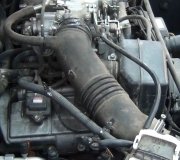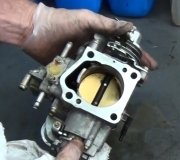Good morning, BBOYLILROB,
At idle you should be at 18-22 inHg at sea level. Your vacuum will decrease about 1" per 1000 ft of elevation. So, if you are at 2,000 ft above sea level 16-20 inHg will be normal for you.
Some engines may have 15-17 inHg at sea level.
At load you should be closer to 0 inHg and slowly rise.
The unit inHg, stands for inches of mercury, which is how vacuum is measured. Your scan tool might be able to change the unit because I think it is going to give you a reading in kPa.
If so, at idle and at sea level you should have about 60-74 kPa.
Here is a kPa-inHg Calculator:
https://convertlive.com/u/convert/inches-of-mercury/to/kilopascals#22
Here is a decent vacuum gauge kit:
https://www.tooldiscounter.com/product/mityvac-vacuum-pressure-gauge-and-fuel-pump-tester-mitmv5511?msclkid=4d10c819bb8013f3db35ac9c57cf793b
If the MAP Sensor is dirty, it could read lower.
An analog gauge on the brake booster line or you could also use a tee at the PCV port on the intake would be better. This way all vacuum lines are connected.
You are going to want to get it up to operating temp and look at it at idle, low cruise (1800-2200 RPM) and high cruise (2500-3000 RPM) for about 15 seconds. Let your foot off the gas. The vacuum reading should jump as the throttle closes. Sometimes to up to around 25 inHg.
Here is a good article about the process which has a lot of other good information in it:
https://www.motor.com/magazine-summary/mastering-the-basics-reading-a-vacuum-gauge/#: :text=Run%20the%20engine%20at%20idle%2C%20low%20cruise%20%281800,and%20watch%20the%20gauge%20as%20the%20speed%20drops.
Another expert also suggested we measure crankcase pressure. Excessive crankcase pressure can push oil out of the engine so I agree it is something we should definitely test as well.
He suggested using a pressure transducer on the dipstick tube, but you will need a waveform viewer to get the measurement. This is the most accurate way, but a waveform viewer is very expensive.
There is another way I found I think is worth a try. It's using something called a manometer and the oil cap. You could get an oil cap from the boneyard, make sure it has a good seal and attach a fitting to it.
The meter is about $50. HVAC techs use them to measure gas pressure at your furnace.
Here is a link to one:
https://www.amazon.com/Manometer-Professional-Pressure-Differential-Measuring/dp/B07CWQJD6D/ref=asc_df_B07CWQJD6D?tag=bingshoppinga-20&linkCode=df0&hvadid=80814160006525&hvnetw=o&hvqmt=e&hvbmt=be&hvdev=c&hvlocint=&hvlocphy=&hvtargid=pla-4584413736956691&psc=1
Here is a video of someone doing this test:
https://youtu.be/8AcvKPYFeDI
It is on a mini, but the theory is the same.
Since the oil is coming out of the valve cover with the oil cap is I think this would be a good place to test.
From what I have found max pressure should be 2.5 to 6.0 psi.
I would also perform a compression test. Your engine is chugging oil, so I want to make sure there isn't an issue with the piston rings. You can rent a tester at a local auto parts store, but they get thrown around and can be very inaccurate. They are pretty cheap, so I would just get a new one. It's a good tool to have.
Here is a link to a decent one that is inexpensive:
https://www.harborfreight.com/compression-test-kit-8-piece-62638.html?utm_source=bing&utm_medium=cpc&utm_campaign=425671834&campaignid=425671834&utm_content=1154488236059904&adsetid=1154488236059904&product=62638&store=639&msclkid=22c0e3b9ea1c1ae7a06e873c3ed78f35
For a spec so far all I can find is:
No cylinder should be below 100psi
No cylinder should be less than 70% of the highest cylinder reading
I think performing these tests will give us some insight as to what might be going on.
When you get home and rest your bones a bit, I would perform these tests. I will guide you through them.
Once we get some measurements, we can take them and start looking at specific areas.
Thank you,
Brendon
Sunday, June 11th, 2023 AT 9:29 AM












